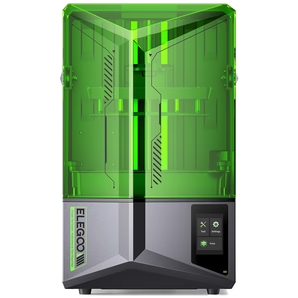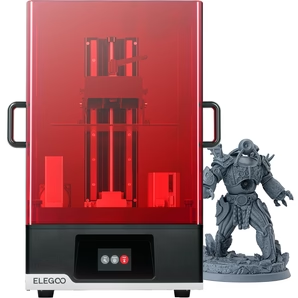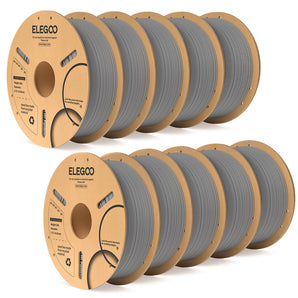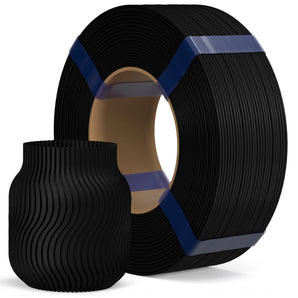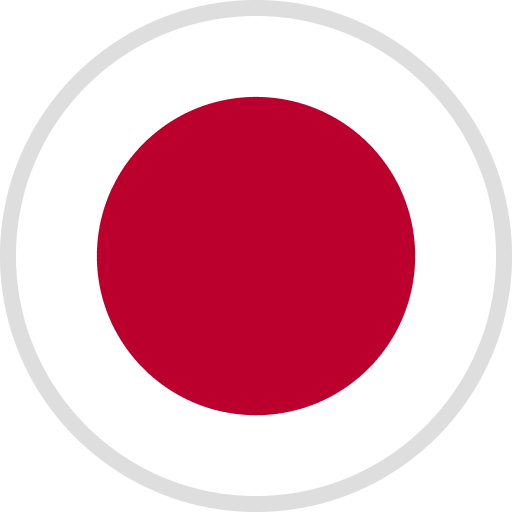LCD 3D Printer 101: Everything You Should Know About It

Source: ELEGOO
3D Printing has had its ups and downs over the years. When it was introduced, the world went crazy with anticipation because the ability to print three-dimensional objects was unheard of, and there was a technology that was providing just that. However, it was very expensive back then due to the cost of setting up the entire machine and the software to run the entire process.
However, that’s no longer a stumbling block. There are a number of new technologies that have been created, bringing down the cost of 3D printing significantly. One of those is the LCD 3D printer.
We are going to explore what an LCD 3D printer machine is, the parts that make it work, the process itself, the benefits it has brought to the industry, and the challenges people who operate them experience. If you have always had a curiosity about how 3D printing is all about, then you are in the right place.
The History of 3D Printing

Source: https://pixabay.com/photos/3d-printer-printing-technology-791205/
3D Printing has been around since the early 80s where it began as a concept that sought to answer the question of whether the more complicated objects can be reproduced within a three-dimensional structure without compromising the structural integrity. The following is a quick timeline of how 3D printing technology has grown over the years to the present.
- 1980: An application for the first patent for RP technology was filed by Dr. Kodama in Japan in the month of May 1980. This set of a series of innovations that spurred a race to get 3D printing technology right.
- 1986: The first official patent was issued to Charles Hull for the Stereolithography Apparatus (SLA). Funding issues are the reason why Dr. Kodama never got the chance to have it issued in his name earlier.
- 1987: A more improved version of the Stereolithography Apparatus was introduced. It was called the SLA-1.
- 1989: A patent was issued for another new 3D printing technology called the Selective Laser Sintering (SLS). The man behind it was Carl Deckard.
- 1990: The first 3D printing apparatus called the Stereos was sold commercially to the public by EOS.
- 1992: Another patent was issued to a newer 3D printing technology. It was issued to Stratasys.
- 1996: The Sanders Prototype, which later changed its name to Solidscape, is set up alongside Z-Corporation.
- 1997: Arcam was established.
- 2000: MCP Technologies introduced the SLM technology for the first time.
- 2004: The first self-replicating 3D printer was conceived by Dr. Bowyer; it was called the RepRap.
- 2007: The first time the price of a 3D printer goes below $10,000. The printer is created by 3D Systems.
- 2009: The first time a 3D printer is made commercially available in STEM kit form based on the RepRap concept.
What followed next was a number of companies like Google investing a lot of money in developing 3D printing further. This not only made them smaller but brought their access closer to the people. Although the technology still has a long way to go, the many contributions that have been added over the years have made it possible for 3D printing to gain so much in a short period of time. It's only a matter of time before they become the norm in the daily lives of people. Now for less than $300, you can get yourself an LCD 3D printer.
What Is an LCD 3D Printer?

Source: ELEGOO
An LCD printer is a type of printer that uses an array of UV LCDs as the source of light. The light emanates from the flat LCD panels and is shined directly in a parallel manner against the surface of the building area. The light is very focused without any expansion, a feature that reduces pixel distortion that is common in many other 3D printing techniques in the market right now.
Due to this, LCD 3D printers are in high demand around the world as their print quality is higher. The higher the LCD density, the more pixels the final output has and the sharper and more realistic it gets.
How LCD 3D Printer Works
As earlier mentioned, the technology behind 3D Printing has become cheaper by the day, and now you can have your own 3D printer in your house. But to safely operate the machine, you have to understand how it works in the first place. The following are the steps that an LCD 3D Printer uses to create an object from scratch.
- Step 1: You begin by pouring the liquid polymer, also called resin, into the crucible. This is then spread by the printer’s roller into a razor-thin layer across the entire platform to make sure that there’s uniformity in terms of thickness. Consistency is key in this situation.
- Step 2: The UV-sensitive liquid polymer is then hit with a computer-controlled UV laser to change the resin into a solid-state from the aqueous solution. In layman’s terms, this is the point where the laser draws the outlines of whatever you are trying to print onto the resin layer, hardening the needed parts only with every touch. The parts that are not needed will not be touched by the laser, and they maintain their liquid state.
- Step 3: The process in step two is repeated over and over again until the entire object takes shape. Every time a layer is completed, the model is powered by a fraction to allow another layer to be added on top. Specific parts are solidified, slowly taking shape underneath until the entire thing is completed.
- Step 4: Once the printing is done, the object is raised out of the resin tank, with the excess fluid flowing back into the tank for further use. The final product is then finished off outside for the final touches. This includes removing the support structures, smoothing surfaces, or spray painting them.
Caution should be excised when handling resin. You should always ensure you are wearing protective gloves and masks because coming into contact with resin is harmful to your health. When washing off the excess resin, make sure you use the correct liquids and don’ drain that water into the sink. Once you have cleaned the excess resin off, don’t touch the final product with bare hands until it undergoes a UV light treatment. You can either let it stand in the sun for a few minutes or if you have a working UV light machine, use it for a few minutes. Once you have covered all that, you are now free to handle the final product.
Benefits of using LCD Technology for 3D Printer
3D printing technology has transformed human lives in ways that cannot be described, and the more advanced and cheaper they become, the more their applications and benefits they bring. The following are some of the notable benefits of using an LCD 3D printer.
Customization

Source: ELEGOO
There is nothing that cannot be made using a 3D printer, and this has made things very convenient. You can make all kinds of additions and omissions in real-time however you want. This has allowed people to create a lot of shapes and objects that would otherwise have been impossible by any other means. You can even see the same printing chamber to create a number of objects at the same time at no added cost at all. The cheaper these machines become the more customization capabilities.
Complexity

Source: ELEGOO
It would cost a lot of money to create objects of great complexity by other normal means like manufacturing. However, 3D printing has made that work faster, cheaper and accessible. You can create objects of such a high level of complexity that could even blow your mind. You are only limited by your imagination. The complexity offered by 3D printers has transformed the lives of designers and artists as they are now able to turn their art into realistic 3D objects without compromising on the detailing and sophistication aspects.
No Need for Tools
3D printing is slated to bring down the cost of manufacturing once it goes into mass production. There are no tools involved in 3D printing, all you require is a computer, a modeling program, and the printer itself, and you are set. This will reduce lead times, the costs of getting tools, and the labor costs of having to operate those tools. The ability to make complex objects without any use of other tools is going to transform the manufacturing industry in a very significant way in the near future. You only need some accessories and add-ons to make the process easier.
Sustainable

Source: https://pixabay.com/illustrations/earth-globe-birth-new-arise-405096/
With fewer tools, less energy, and less raw materials, 3D printing is the most eco-friendly manufacturing process so far. The utilization rate of raw materials is over 90%, with most of the residue recyclable, which means nothing really goes to waste. The finished products are also very hardy and durable, which gives them a decent longevity period of use before they are discarded; this reduces the number of plastics in the environment.
The best part of 3D printing is that finally, manufacturing can be controlled based on need and demand rather than manufacturing in anticipation of demand which leads to surplus and waster of energy. This will eliminate huge inventories, the need to hire storage as well as cut down on the costs of transportation.
Rapid Prototyping
3D printing is becoming faster by the day, and when you consider that it involves creating something from scratch using rudimentary raw materials, the sheer brilliance behind the technology starts making sense. One of the manufacturing processes that has benefited greatly from these increased speeds is the prototyping segment, where different parts of the same items can be made at the same time in concurrent processes and later joined up, cutting down the time needed to create products. Once this goes full scale, we will experience manufacturing speeds never seen before.
How to Choose a High Quality LCD 3D Printer

Source: https://unsplash.com/photos/FB1vd3XT_zQ
A good LCD 3D printer will save you a lot of money and headache. There are currently a good number of models and brands in the market, each claiming to be better than the next. Making the selection can therefore be a little confusing if you don't know what it is you are looking for exactly. The following are some of the factors you have to keep in mind when choosing a quality LCD 3D printer.
- Size of the print bed: The bigger the bed, the bigger the prints you can make and vice versa. A bigger bed also means you can print several products at the same time concurrently without interfering with the quality of each. This could come in handy considering how time-consuming and complicated setting up the inter for a single operation can be.
- Calibration: Some machines require the user to calibrate them before use, and this can be a little time-consuming. It involves adjusting the nozzle until it assumes the right position. You would be served better going for a primer that comes with automated calibration, but that will cost you extra.
- Cost of resin: Resin is the material used to make the products, and it is not cheap. There are many types in the market, and each has its own unique properties. Most are sold per pound, and they can vary from $35-$70. As 3D printing picks up, the resin is expected to become cheaper, but at the moment, these are the prices that are in the market.
- The Software: There are two types of software you have to deal with. The first one is the modeling software that you use to design the products you want to print. It has to have all the tools, and it must be compatible with the printer. The second software is the one that runs the printer. It should be ‘open source,’ meaning it has to be customizable, allowing the user to set it in line with their needs.
- LCD display: A primer that allows you to operate without the need for a computer nearby is more convenient. Having an LCD display with controller boards makes your work easier as you have fewer buttons to deal with. It also reduces the complications associated with setting up a computer nearby.
- Durability and ease of maintenance: As much as their prices have come down considerably, there’s no reason why you should have to be subjected to breakdowns and the need for maintenance after every use. Go for a 3D printer that is durable and can run for long without any maintenance. Having to troubleshoot problems every few days will disrupt the quality and speed of your work.
Conclusion
Current trends and the space of development point to a future where 3D printers will be so widespread that people will own them in their houses the same way they own electronics. This will change consumption patterns for people as they will have the power to create most of what they need, and that is a good thing. If you are interested in knowing more about LCD 3D printers, feel free to check out the website at your own time, and if you have any questions, our team of experts will be there to address every single one of them.


































